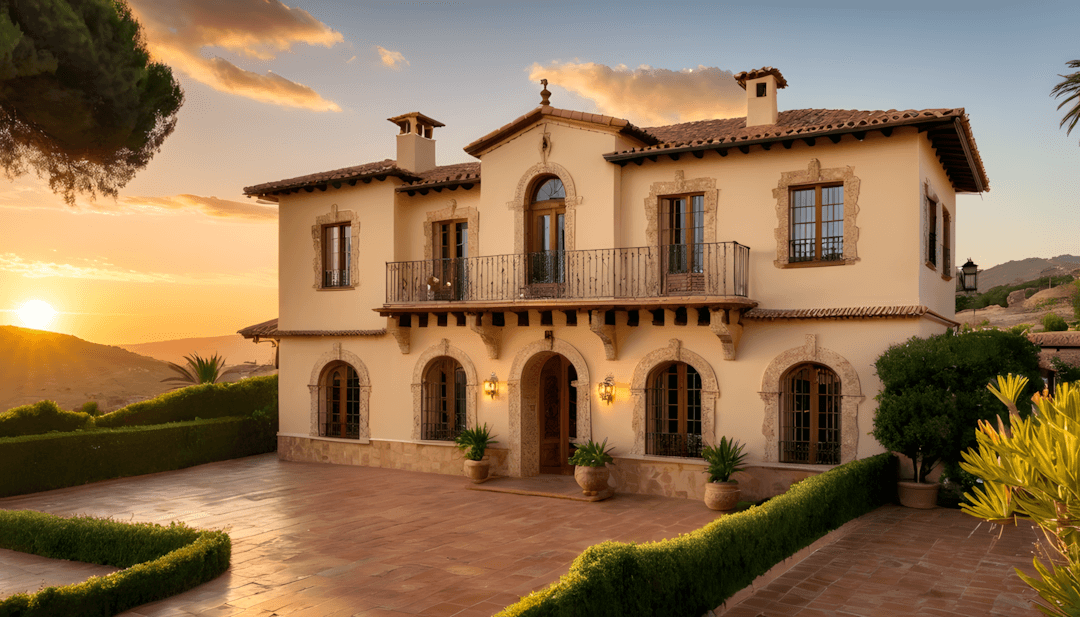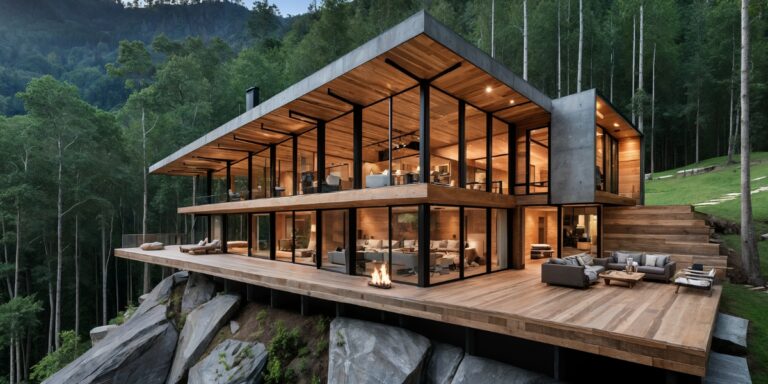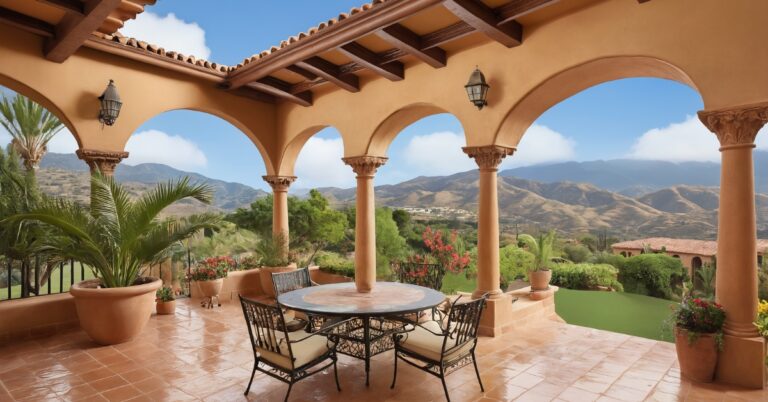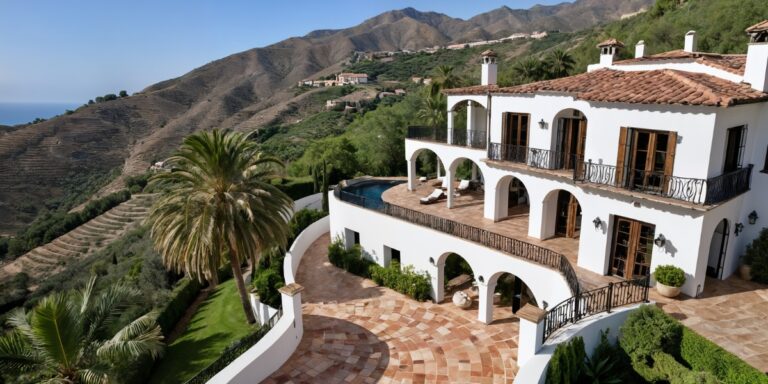In my experience working with homeowners on Mediterranean and Spanish-inspired architectural projects, I’ve observed that Spanish-style homes often create remarkably enduring and appealing exterior designs. Through various projects, I’ve learned that this architectural approach typically combines practical climate adaptation with aesthetic beauty while maintaining characteristics that have remained popular across different regions and time periods.
Note: For any structural modifications, electrical work, or major architectural changes mentioned in this article, always consult with licensed professionals to ensure safety, structural integrity, and code compliance.
What makes Spanish-style architecture particularly appealing to many homeowners is its emphasis on outdoor living and natural materials that age gracefully. I’ve found that people often choose this approach because it typically creates homes that feel both elegant and livable while working well with various climate conditions and landscape settings.
The key to successful Spanish-style design often lies in balancing traditional elements with practical modern needs. Effective Spanish-inspired exteriors typically embrace characteristic materials like stucco and clay tiles while incorporating features that enhance both aesthetic appeal and functional performance for contemporary family life.
Here are 21 approaches to Spanish-style home exteriors that often work well in different geographic and climatic settings, based on observations from various Mediterranean-inspired architectural projects.
1. Classic Estate Elements
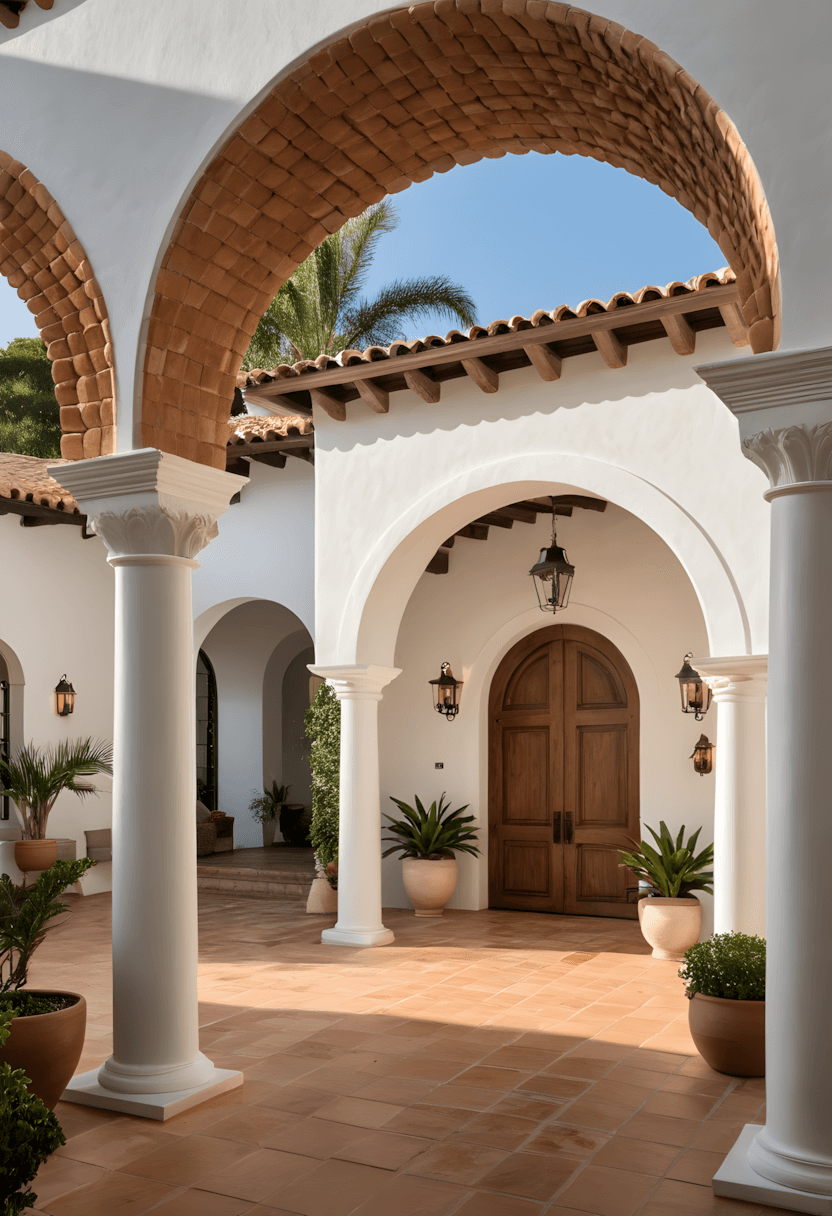
This traditional approach often appeals to homeowners seeking formal, refined character. Red clay tile roofing typically provides authentic appearance while offering excellent weather protection and thermal performance in various climates.
Design consideration: Traditional tile systems often require proper structural support while their natural color variations provide visual interest that enhances rather than detracts from overall design unity.
Practical benefit: Quality clay tiles typically offer exceptional longevity while providing natural insulation properties that can improve energy efficiency in both hot and moderate climates.
2. Single-Story Hacienda Layout
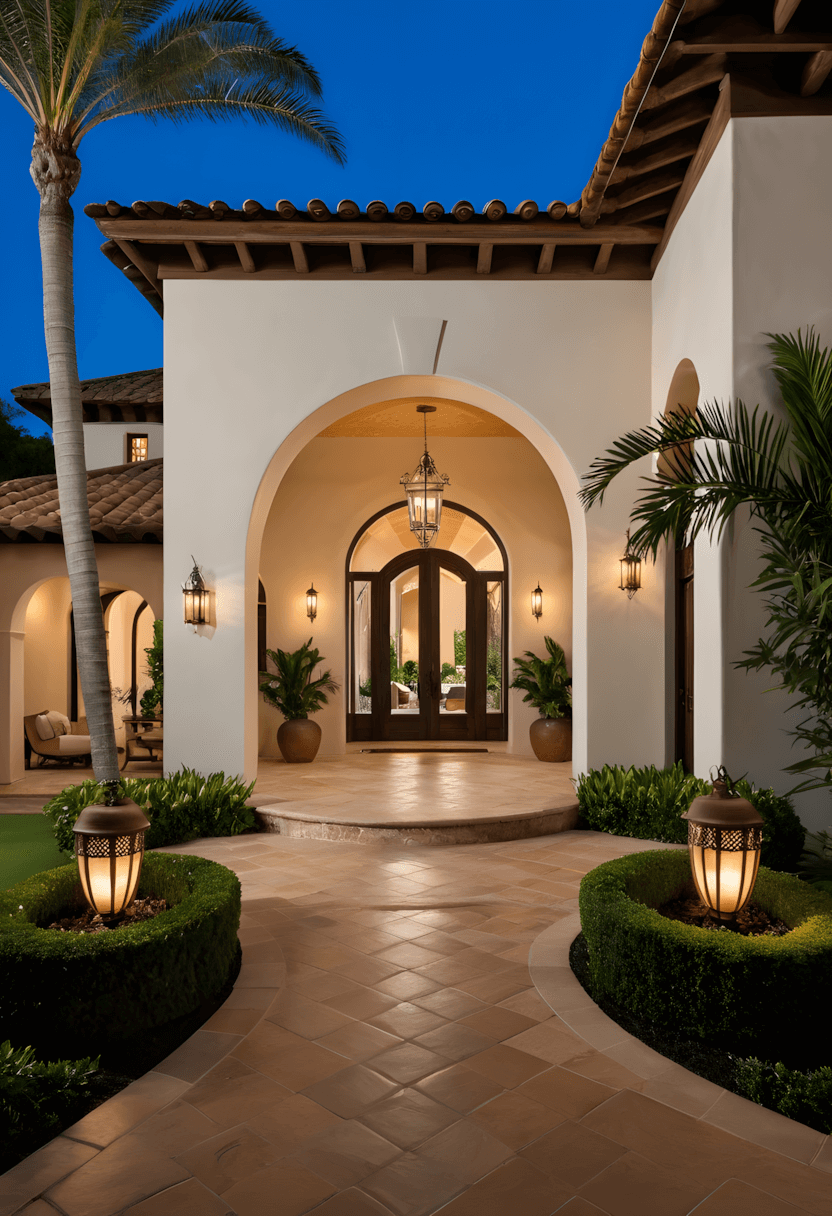
This horizontal approach often appeals to those wanting accessible, ground-level living. Courtyard-centered designs typically provide private outdoor spaces while creating natural climate control through shading and air circulation.
Design consideration: Single-story layouts often require larger lot sizes while their sprawling nature can create opportunities for multiple outdoor living areas and garden integration.
Practical benefit: Ground-level designs typically offer easier maintenance access while providing natural aging-in-place capabilities that accommodate changing mobility needs over time.
3. Mediterranean Villa Adaptation
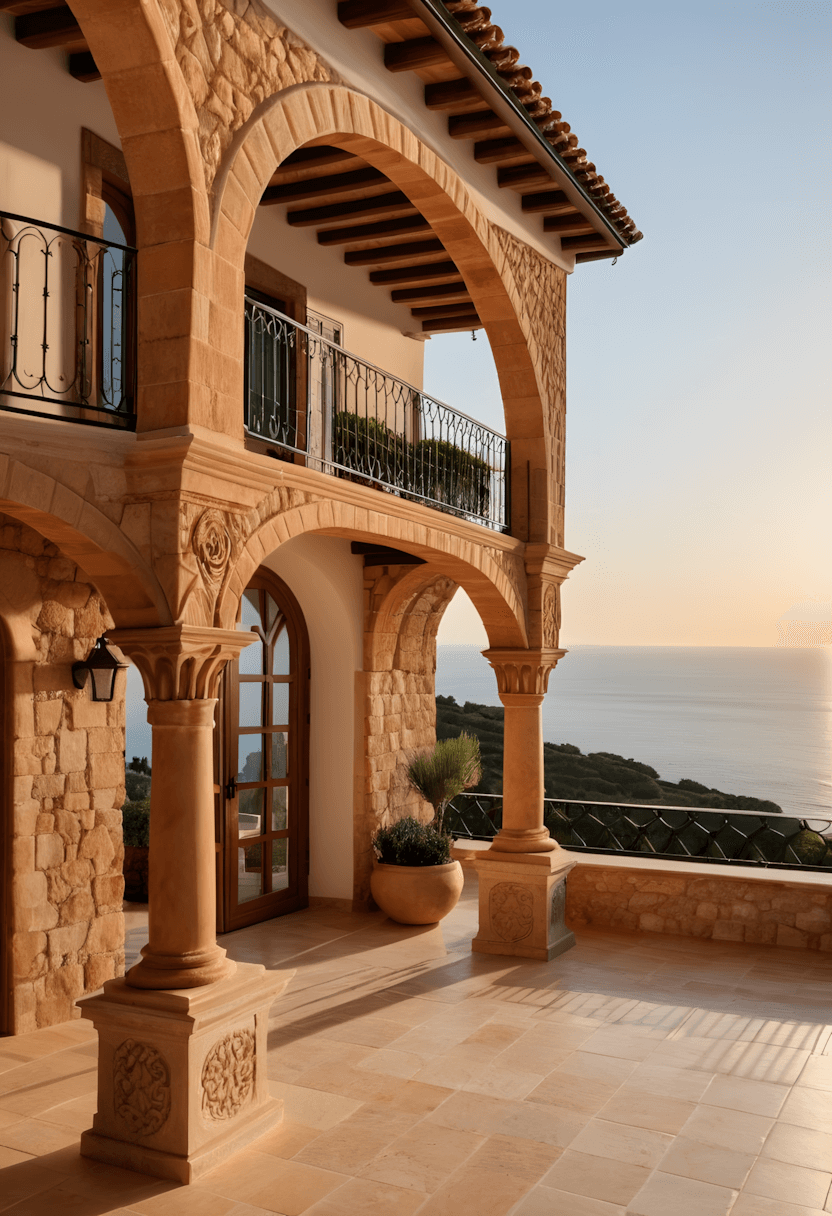
This multi-story approach often appeals to homeowners wanting dramatic architectural presence. Layered roofing and varied elevations typically create visual interest while providing opportunities for ocean or landscape views from upper levels.
Design consideration: Multi-level designs often require careful drainage planning while their complex rooflines can provide architectural drama that enhances curb appeal and property value.
Practical benefit: Vertical layouts typically maximize living space on smaller lots while providing natural separation between public and private areas within the home.
4. Integrated Courtyard Design
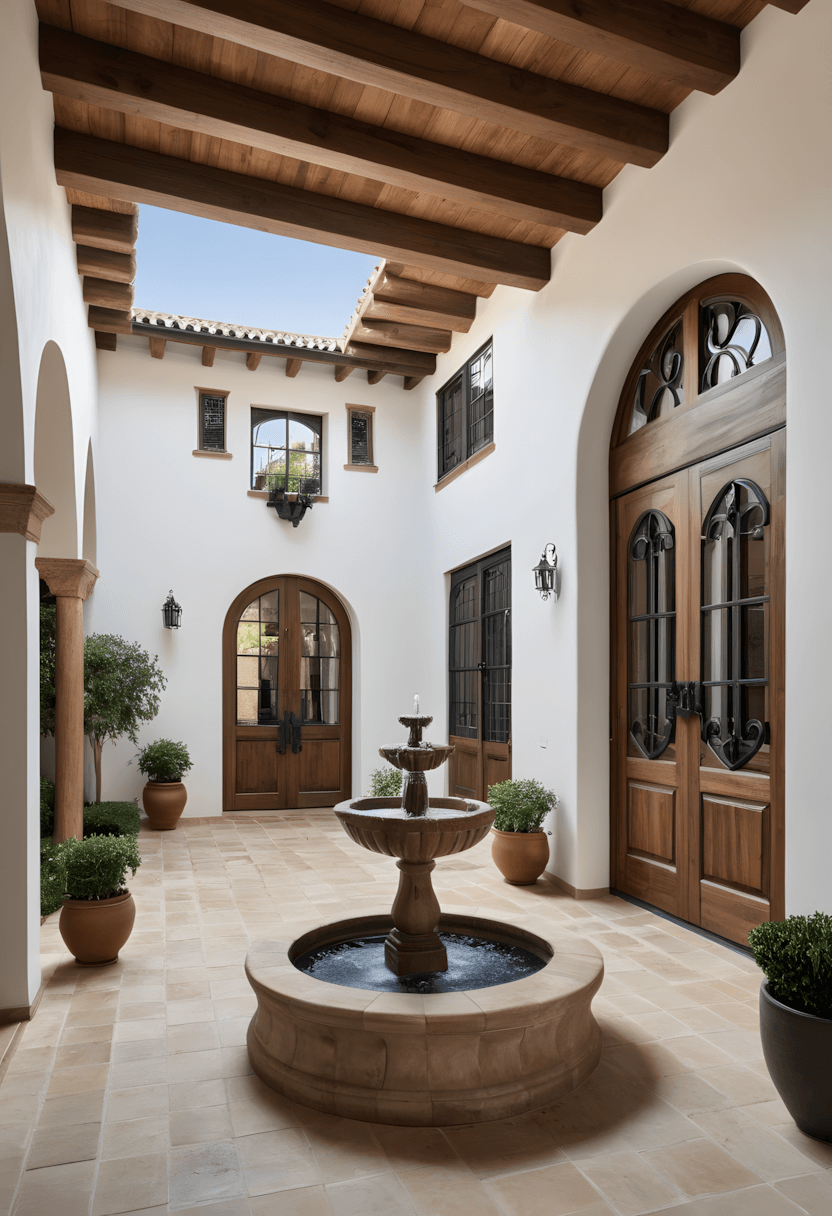
This planning approach often appeals to families prioritizing outdoor living and privacy. Central courtyards typically provide protected outdoor spaces while creating natural focal points that organize interior room arrangements.
Design consideration: Courtyard designs often require careful consideration of drainage and privacy while their inward focus can provide peaceful retreats from busy neighborhood environments.
Practical benefit: Protected outdoor spaces typically extend usable living areas while providing natural climate control that reduces energy costs and enhances comfort.
5. Distinctive Tower Features
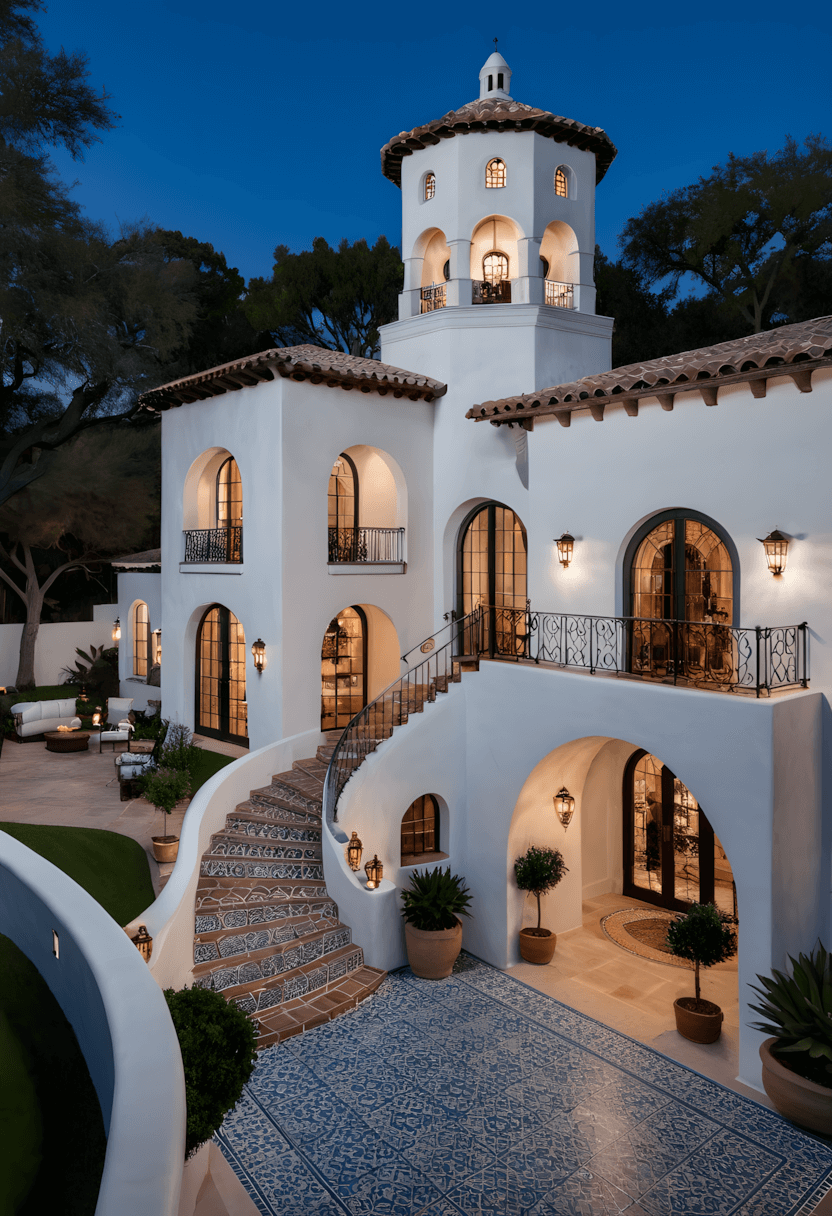
This vertical approach often appeals to those wanting unique architectural character. Tower elements typically provide dramatic focal points while offering opportunities for distinctive interior spaces like studies or observation areas.
Design consideration: Tower construction often requires specialized structural engineering while their prominent nature can create opportunities for interesting interior spatial experiences.
Practical benefit: Vertical elements typically provide additional square footage while offering unique spaces that can enhance property distinctiveness and potential resale value.
6. Coastal Adaptation Elements
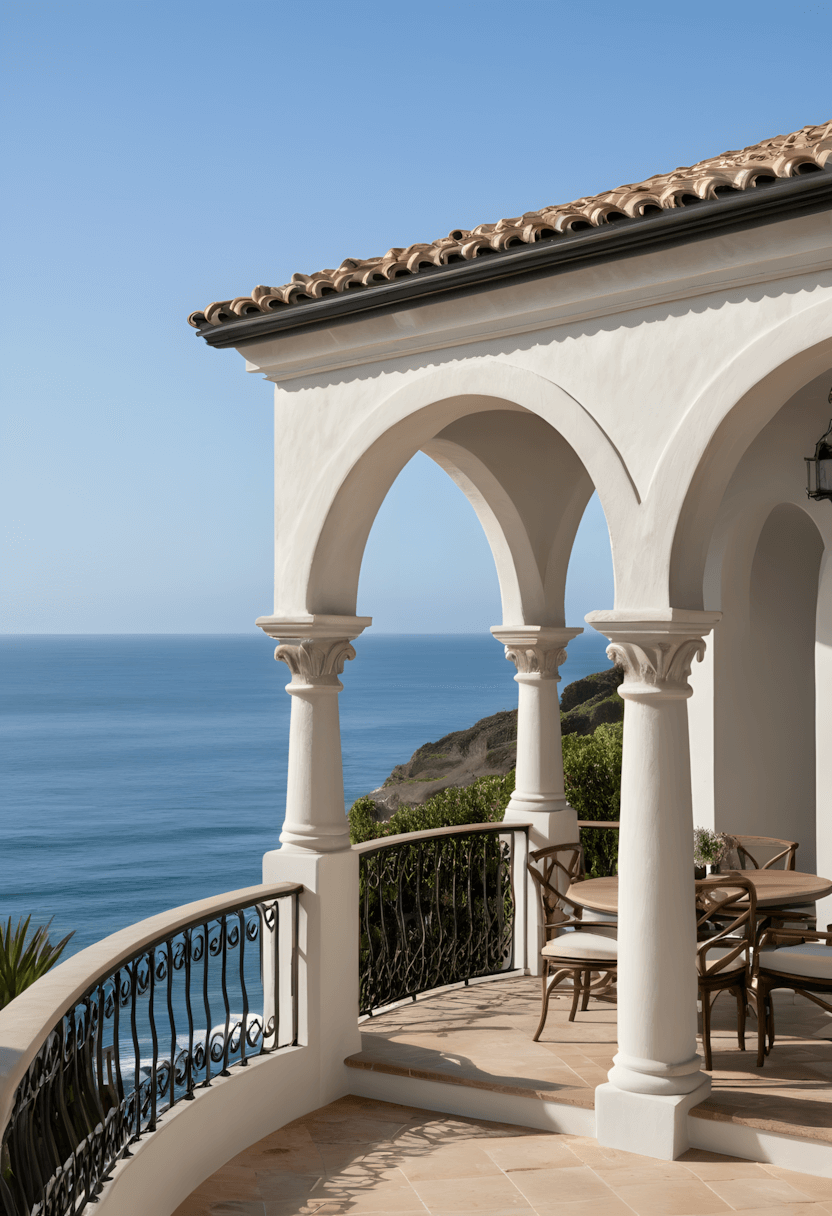
This environmental approach often appeals to homeowners in seaside locations. Salt-resistant materials and coastal color palettes typically provide appropriate responses to marine environments while maintaining Spanish aesthetic character.
Design consideration: Coastal locations often require specialized material selection while ocean proximity can provide opportunities for dramatic views and outdoor entertainment areas.
Practical benefit: Marine-appropriate materials typically offer superior longevity in coastal conditions while proper design can maximize ocean views and natural ventilation benefits.
7. Mission-Inspired Features
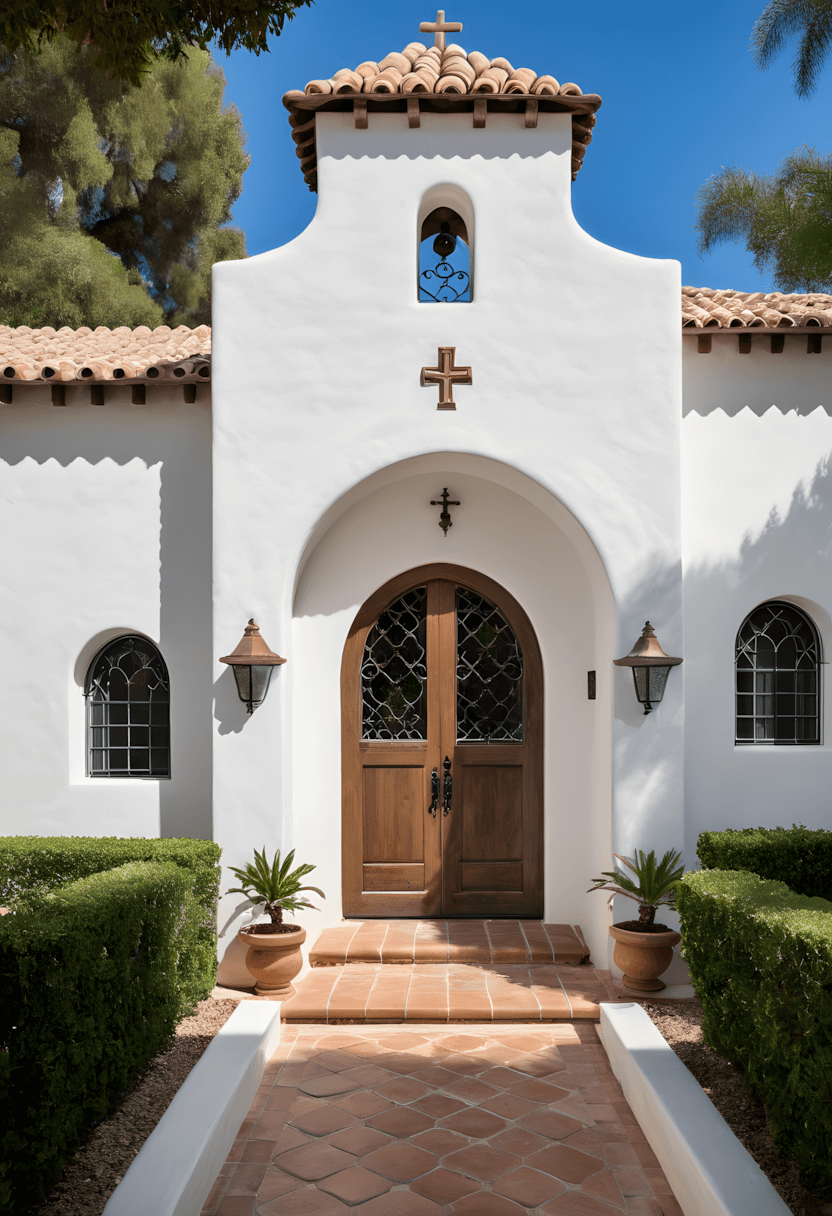
This historical approach often appeals to those appreciating California’s architectural heritage. Mission elements like bell towers typically provide distinctive character while connecting homes to regional architectural traditions.
Design consideration: Historical references often require careful interpretation while authentic details can provide unique character that distinguishes properties from generic interpretations.
Practical benefit: Traditional design elements typically maintain relevance longer while quality historical detailing can enhance property value and cultural significance.
8. Colonial Courtyard Integration
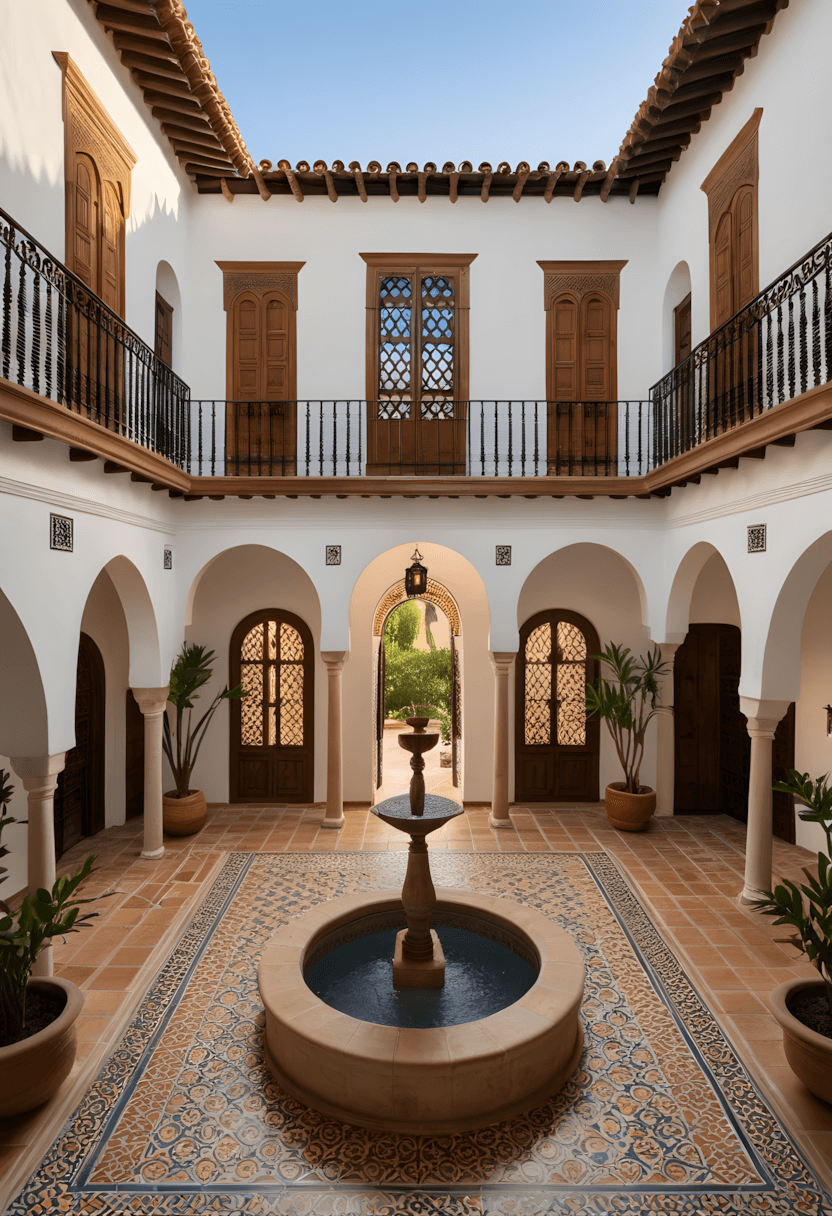
This formal approach often appeals to homeowners wanting sophisticated outdoor entertaining spaces. Connected courtyards typically provide varied outdoor experiences while maintaining visual unity through consistent material and design treatments.
Design consideration: Multiple outdoor spaces often require coordinated design planning while their variety can accommodate different activities and seasonal preferences.
Practical benefit: Diverse outdoor areas typically accommodate various family needs while providing flexibility for entertainment, relaxation, and practical activities like gardening.
9. Climate-Responsive Design
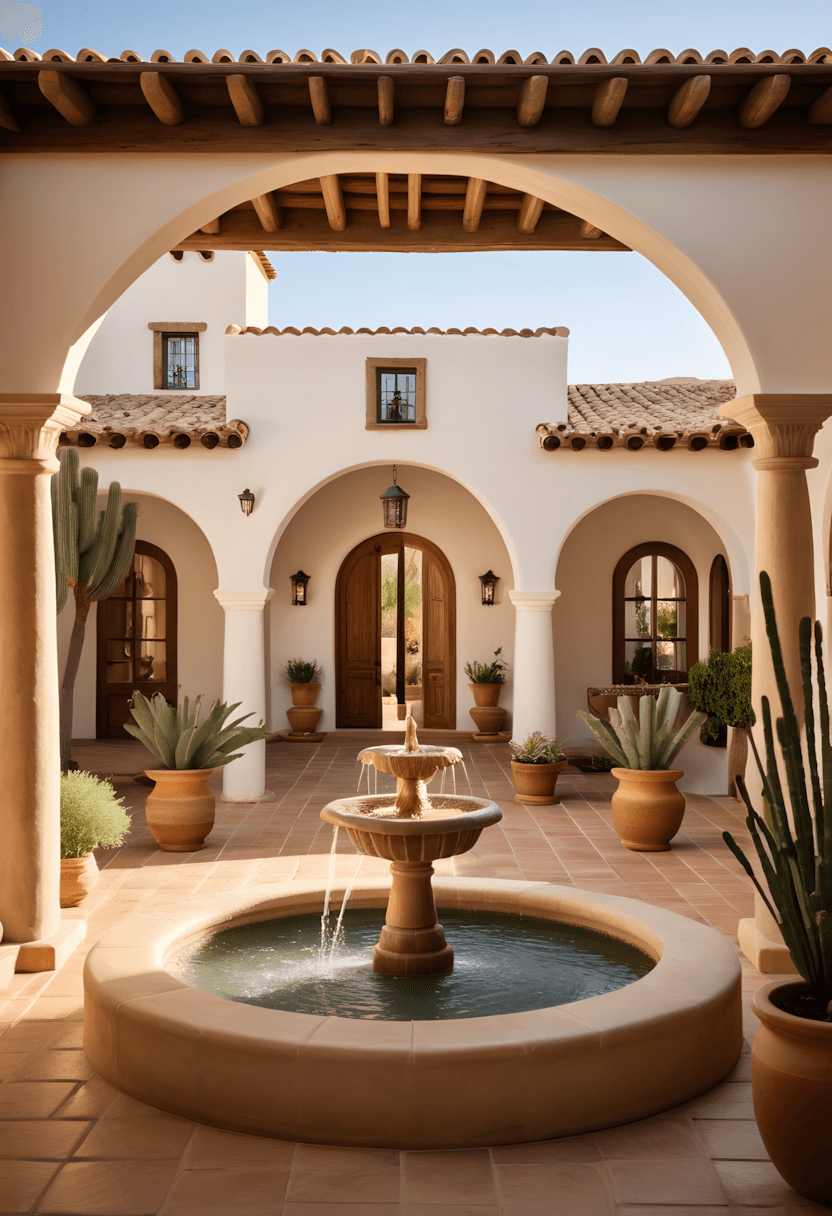
This practical approach often appeals to those in challenging climatic conditions. Thick walls and deep-set openings typically provide natural climate control while reducing dependence on mechanical heating and cooling systems.
Design consideration: Climate adaptation often influences overall proportions while proper orientation can maximize natural comfort and minimize energy consumption throughout the year.
Practical benefit: Passive climate features typically reduce utility costs while providing superior comfort that enhances daily living quality and environmental sustainability.
10. Period Revival Characteristics
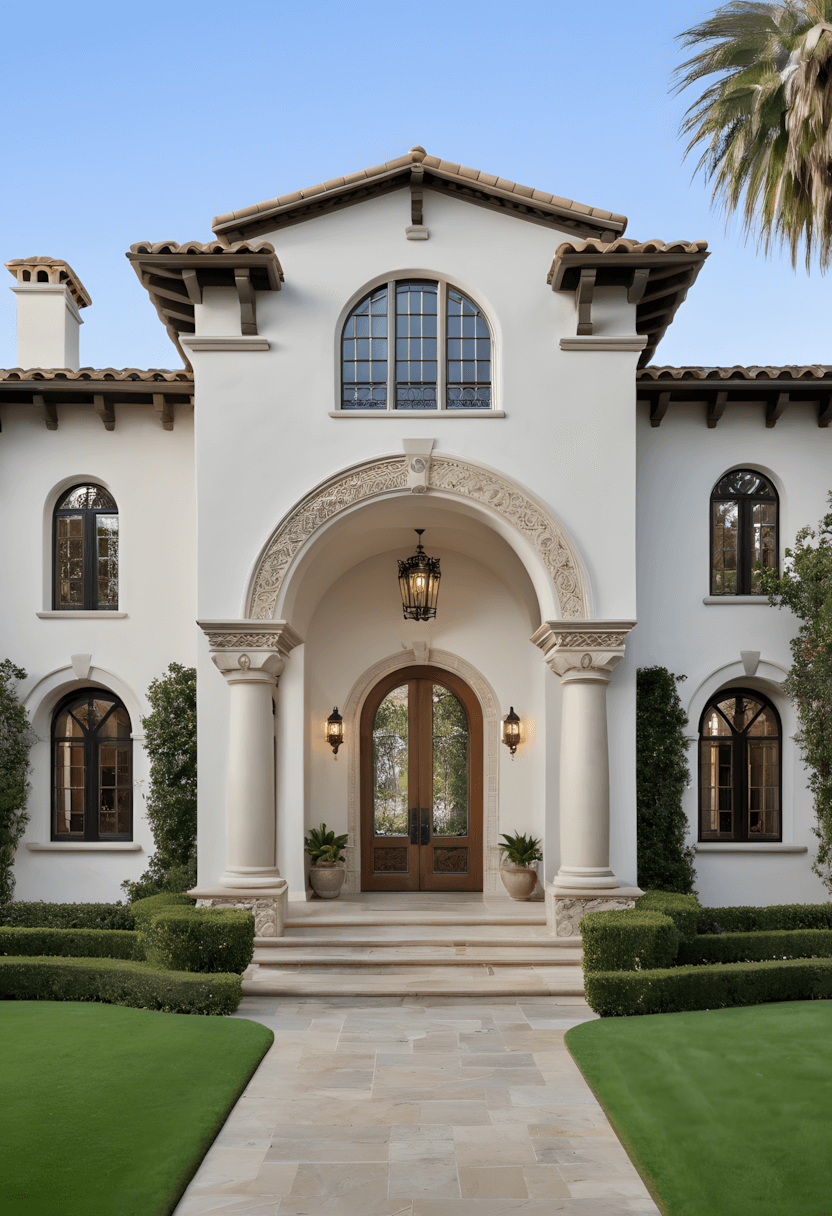
This historical approach often appeals to homeowners appreciating specific architectural eras. Period-appropriate details typically provide authentic character while showcasing traditional craftsmanship and design sophistication.
Design consideration: Historical accuracy often requires research and specialized knowledge while period details can provide unique character that enhances architectural integrity.
Practical benefit: Authentic period features typically maintain their appeal longer while quality traditional details can significantly enhance property value and cultural significance.
11. Contemporary Interpretation
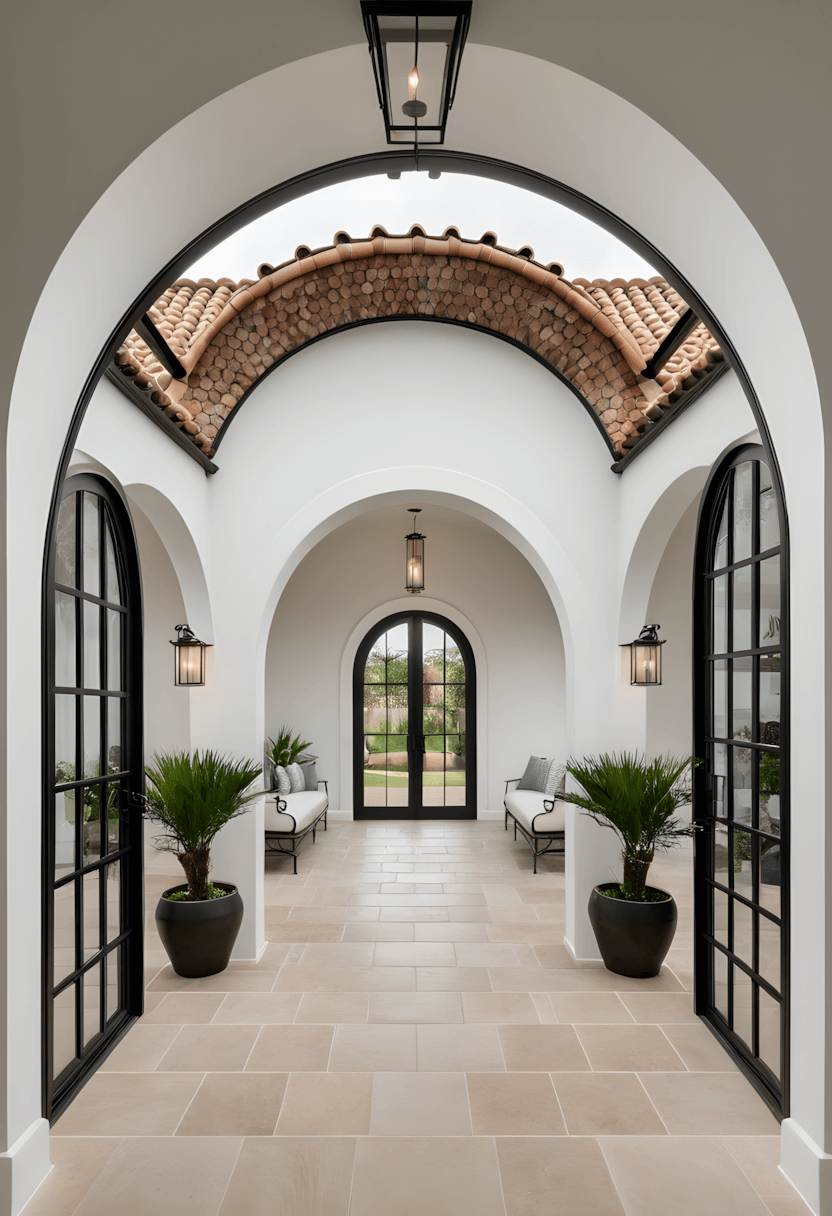
This modern approach often appeals to those wanting Spanish character with updated functionality. Streamlined traditional elements typically provide familiar aesthetic appeal while accommodating contemporary lifestyle needs and maintenance requirements.
Design consideration: Modern interpretations often require balancing tradition with innovation while contemporary materials can provide improved performance and reduced maintenance needs.
Practical benefit: Updated designs typically offer better energy efficiency while maintaining beloved aesthetic qualities that provide enduring appeal and market value.
12. Regional Adaptation Features
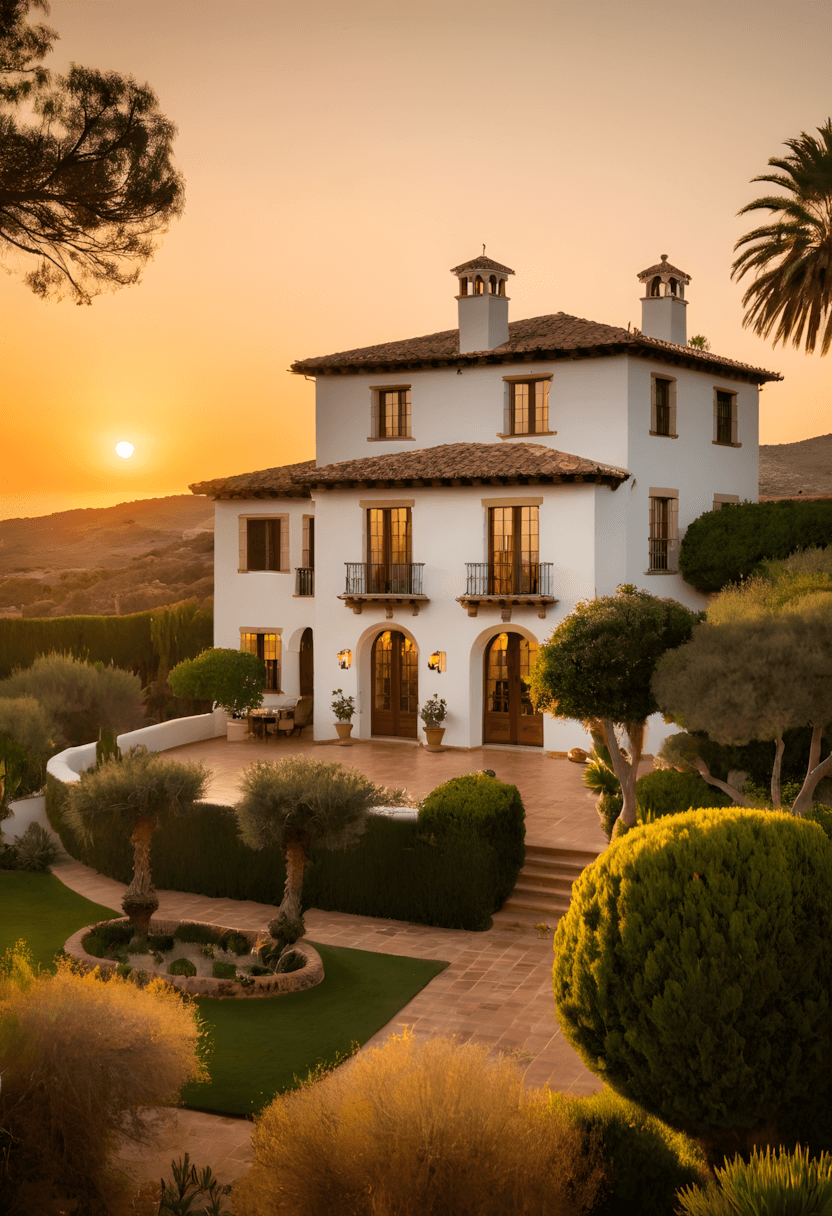
This geographic approach often appeals to homeowners wanting authentic regional character. Area-specific elements typically provide appropriate cultural connections while ensuring design compatibility with local climate and traditions.
Design consideration: Regional authenticity often requires understanding local architectural heritage while specific details can provide unique character that enhances neighborhood compatibility.
Practical benefit: Locally appropriate designs typically perform better in specific climates while providing cultural connections that enhance community integration and property relevance.
13. Ranch-Style Integration
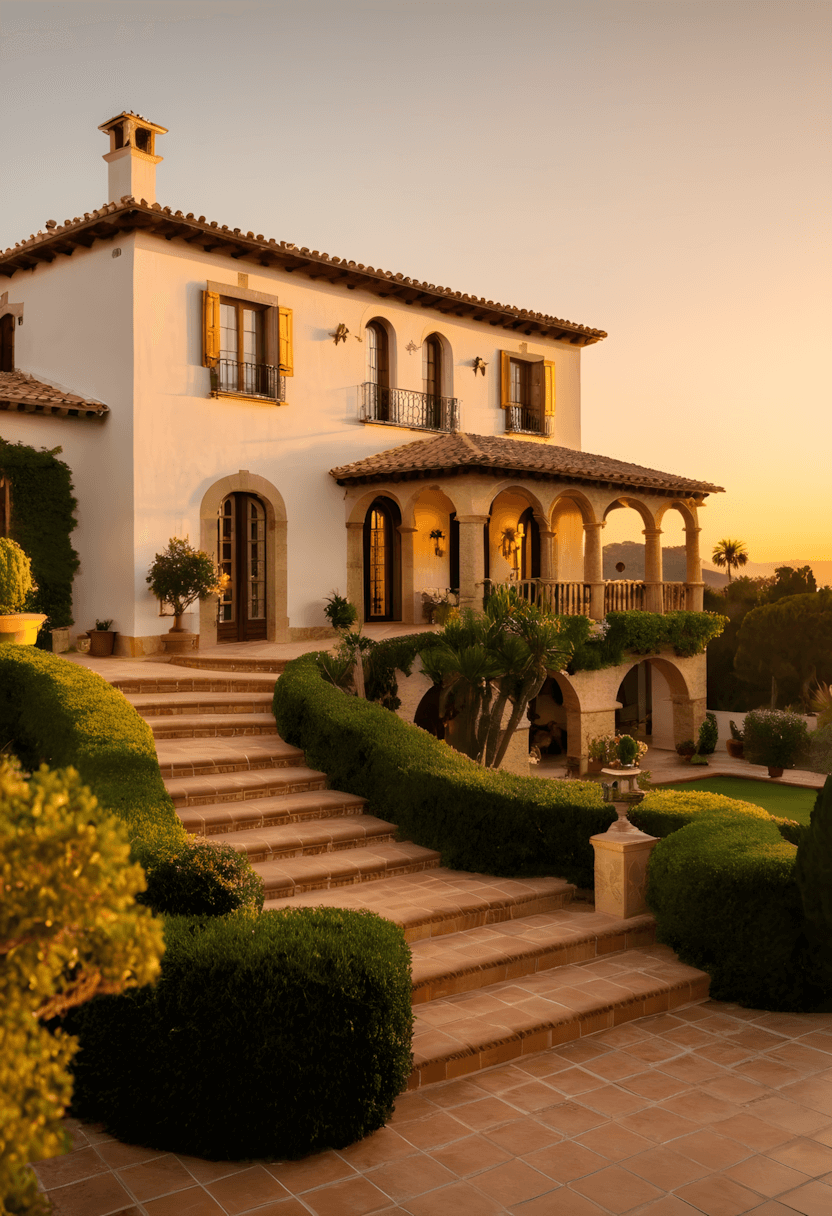
This American approach often appeals to families wanting Spanish character with familiar layouts. Horizontal emphasis typically provides accessible living while incorporating Spanish materials and details that enhance aesthetic appeal.
Design consideration: Ranch adaptations often require creative integration of Spanish elements while maintaining the practical benefits of single-story, flowing floor plans.
Practical benefit: Familiar layouts typically offer practical family living while Spanish details provide unique character that distinguishes properties from standard ranch designs.
14. Luxury Coastal Features
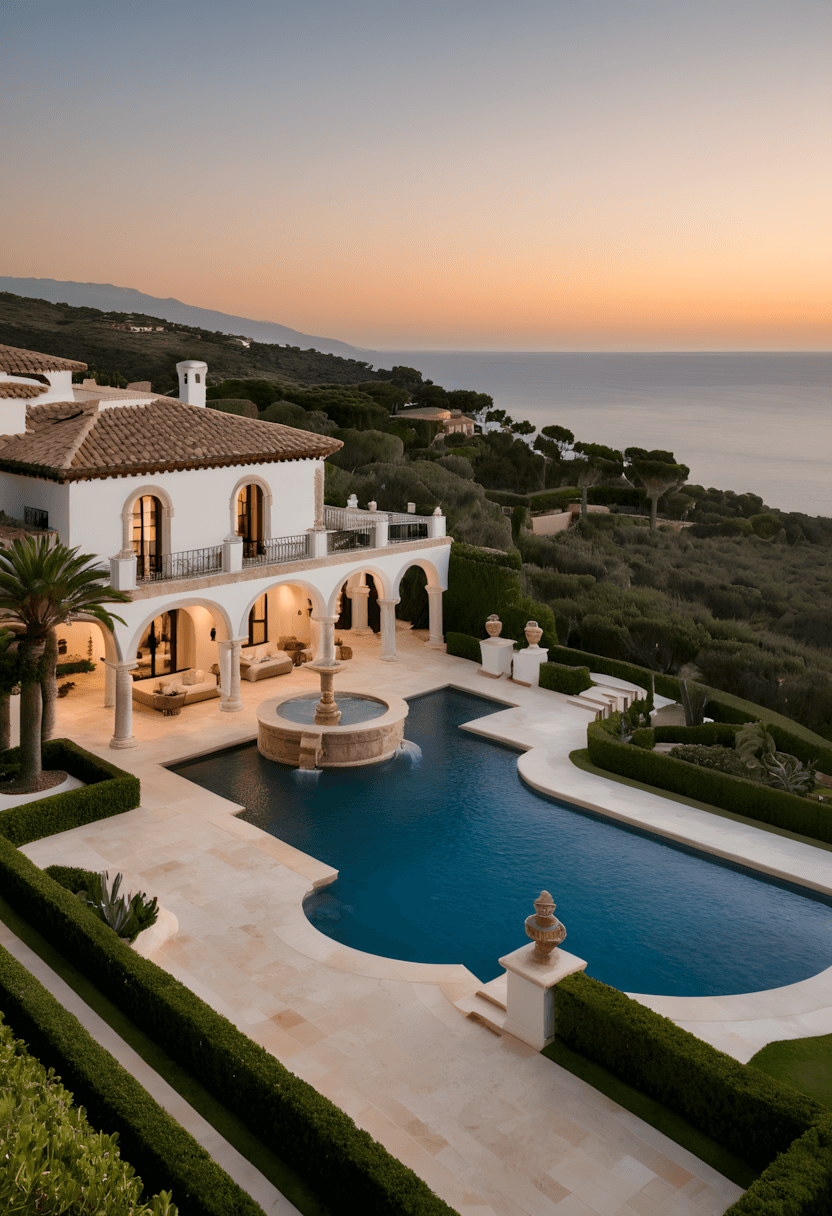
This upscale approach often appeals to homeowners wanting resort-like amenities. Multiple outdoor living areas typically provide varied entertainment options while high-quality materials enhance both beauty and durability.
Design consideration: Luxury features often require significant investment while their quality can provide lasting satisfaction and superior property value retention.
Practical benefit: Premium materials typically offer exceptional longevity while resort-quality amenities can provide daily lifestyle enhancement that justifies the investment.
15. Gothic-Spanish Fusion
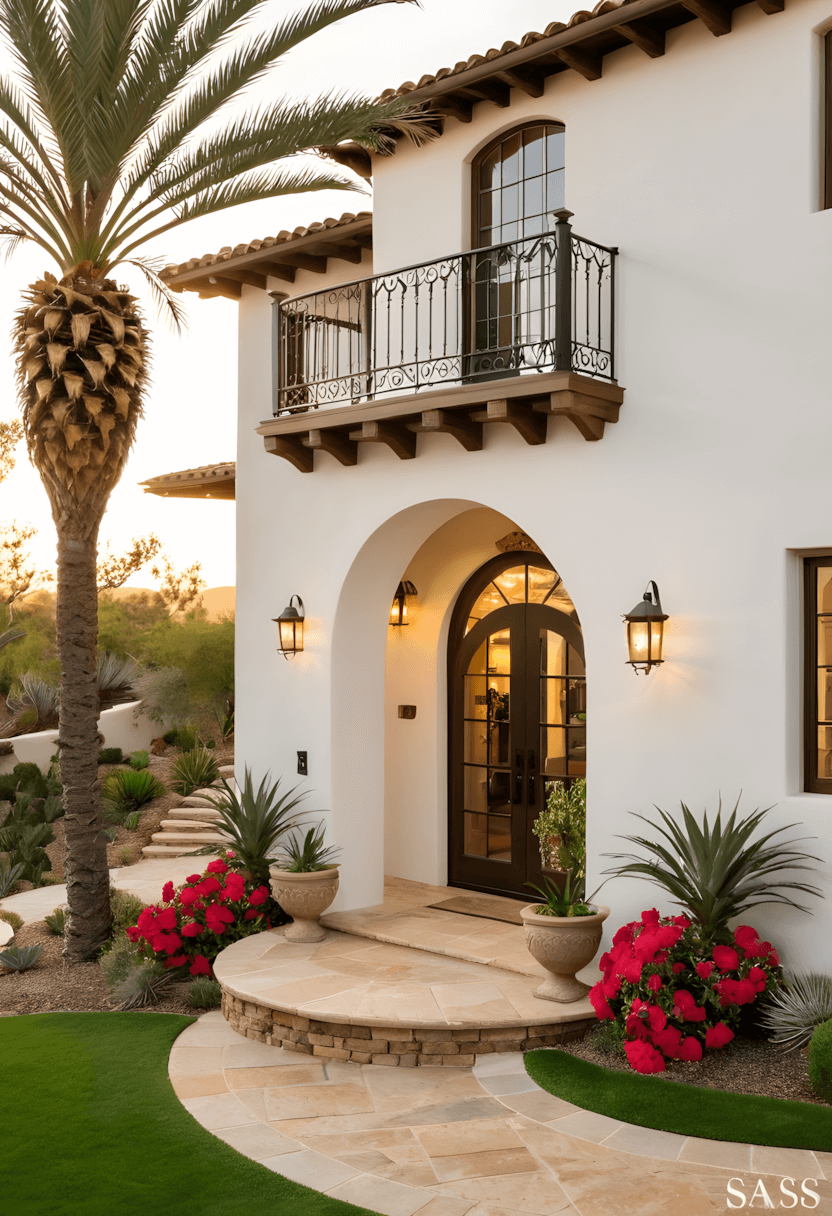
This eclectic approach often appeals to those wanting unique architectural character. Mixed stylistic elements typically create distinctive properties while requiring careful design balance to achieve harmonious overall composition.
Design consideration: Style mixing often requires sophisticated design knowledge while successful combinations can create truly unique properties that stand out in any neighborhood.
Practical benefit: Distinctive designs typically offer memorable character while unique properties often maintain or increase their value due to their irreplaceable nature.
16. Monterey Colonial Style
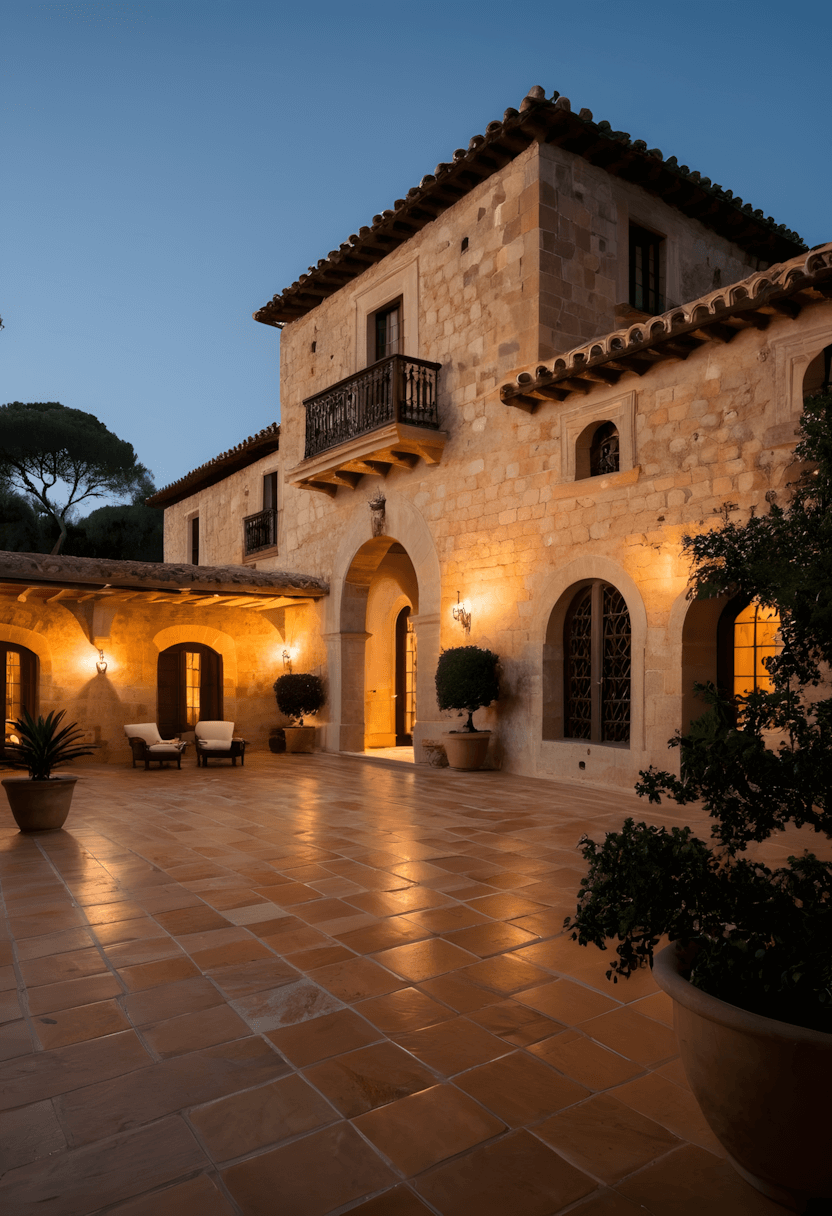
This regional approach often appeals to homeowners appreciating California’s specific architectural heritage. Monterey features typically provide appropriate regional character while offering practical benefits like covered porches and natural insulation.
Design consideration: Regional styles often work best in appropriate geographic contexts while their specific features can provide both aesthetic appeal and practical climate benefits.
Practical benefit: Traditional regional features typically offer proven performance while authentic details can enhance property value and cultural significance within appropriate markets.
17. Intimate Cottage Scale
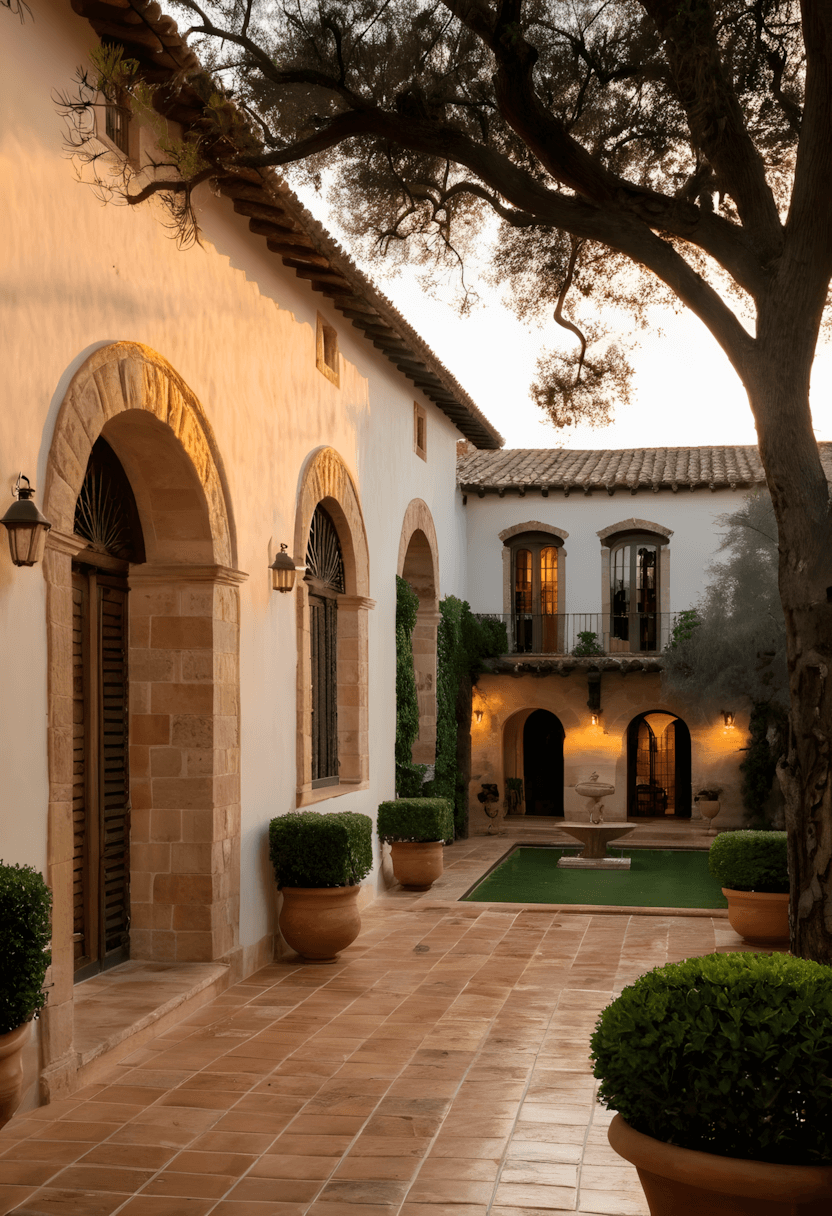
This smaller approach often appeals to those wanting Spanish character in more modest homes. Cottage proportions typically provide cozy, approachable character while maintaining essential Spanish design elements at an appropriate scale.
Design consideration: Smaller scales often require careful proportion management while intimate sizes can provide charming character that appeals to various market segments.
Practical benefit: Cottage sizes typically offer lower maintenance requirements while providing distinctive character that can compete effectively with larger, more generic properties.
18. Plaza-Centered Organization
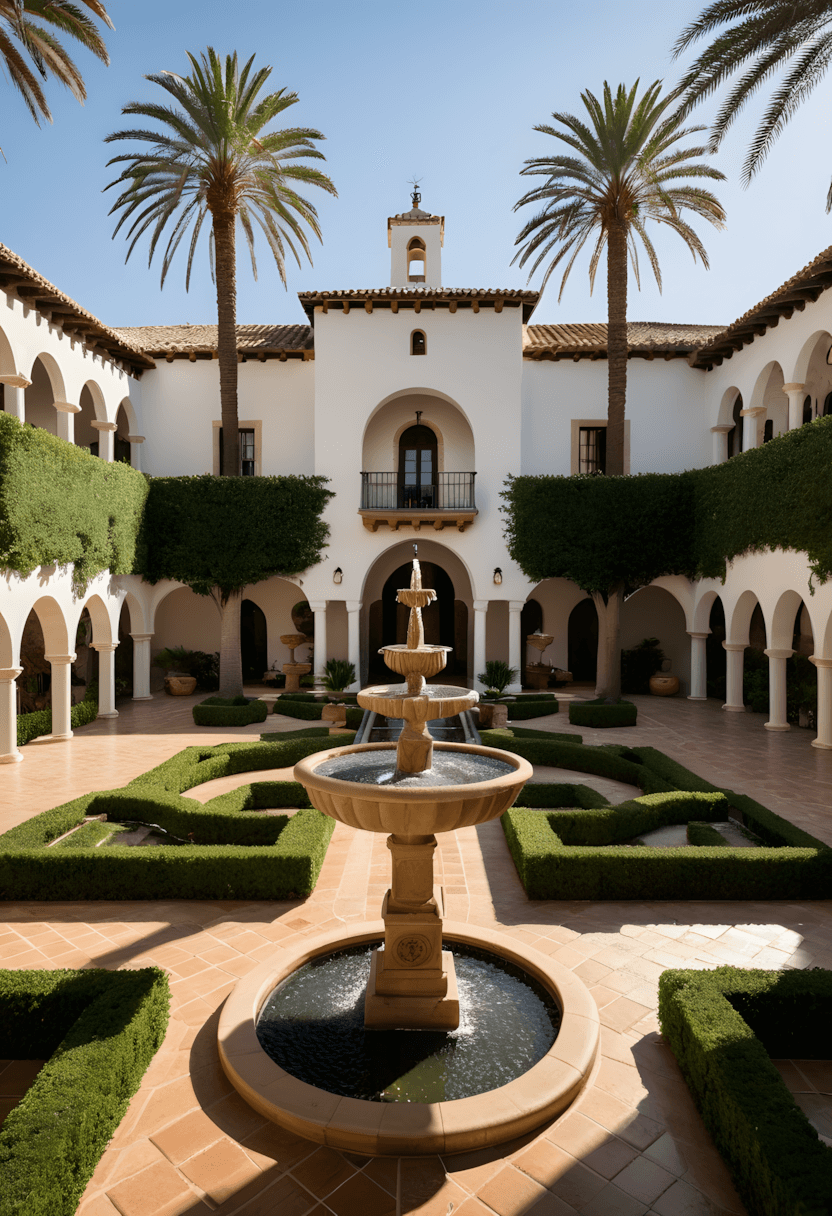
This planning approach often appeals to families wanting cohesive outdoor living. Central organizing elements typically provide focal points while connecting various building components into unified compositions.
Design consideration: Plaza designs often require significant lot sizes while their organizing principles can create compelling outdoor living experiences that enhance family life.
Practical benefit: Organized outdoor spaces typically provide better functionality while unified designs can create property distinctiveness that enhances market appeal and value.
19. Hillside Adaptation Features
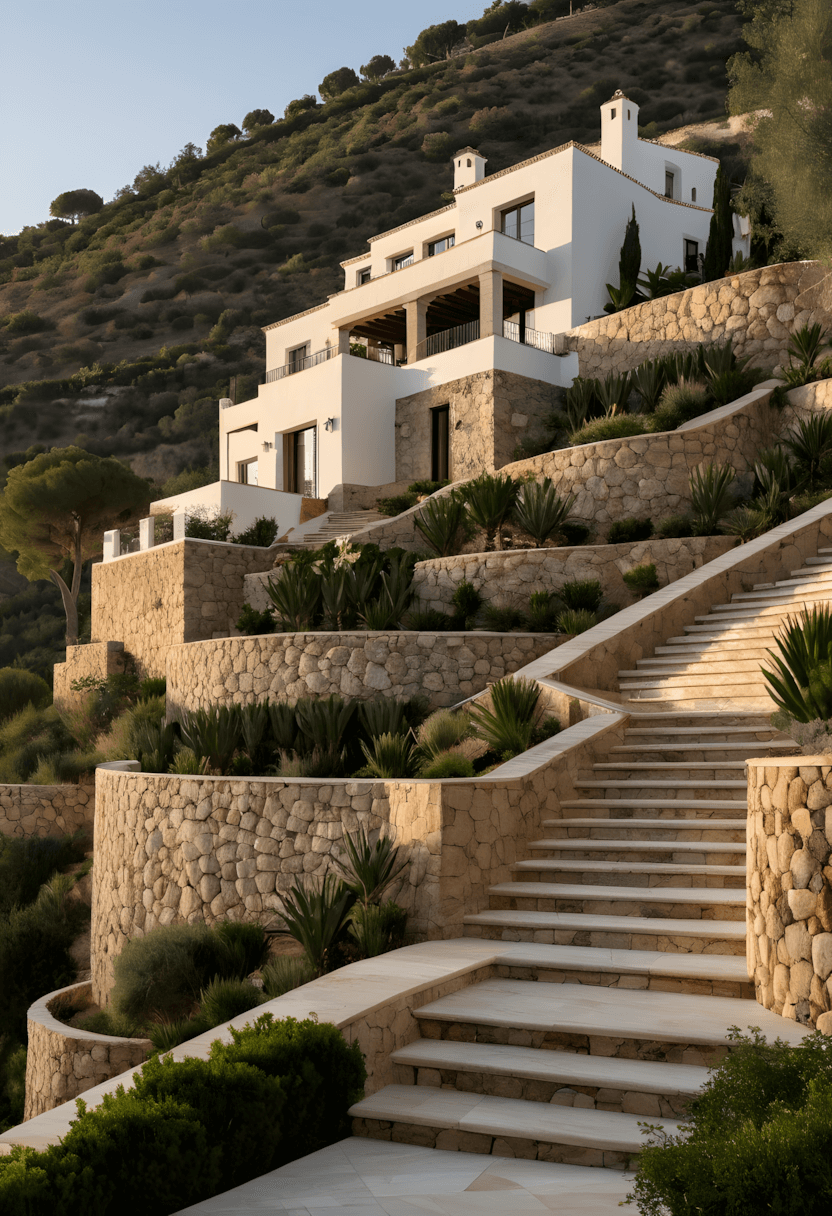
This topographic approach often appeals to homeowners with challenging sites. Terraced designs typically work with natural slopes while creating usable outdoor spaces and interesting architectural compositions.
Design consideration: Hillside sites often require specialized engineering while their challenges can create opportunities for dramatic designs and superior views.
Practical benefit: Slope adaptation typically maximizes site potential while proper terracing can prevent erosion and create valuable outdoor living areas from challenging terrain.
20. Simplified Contemporary Elements
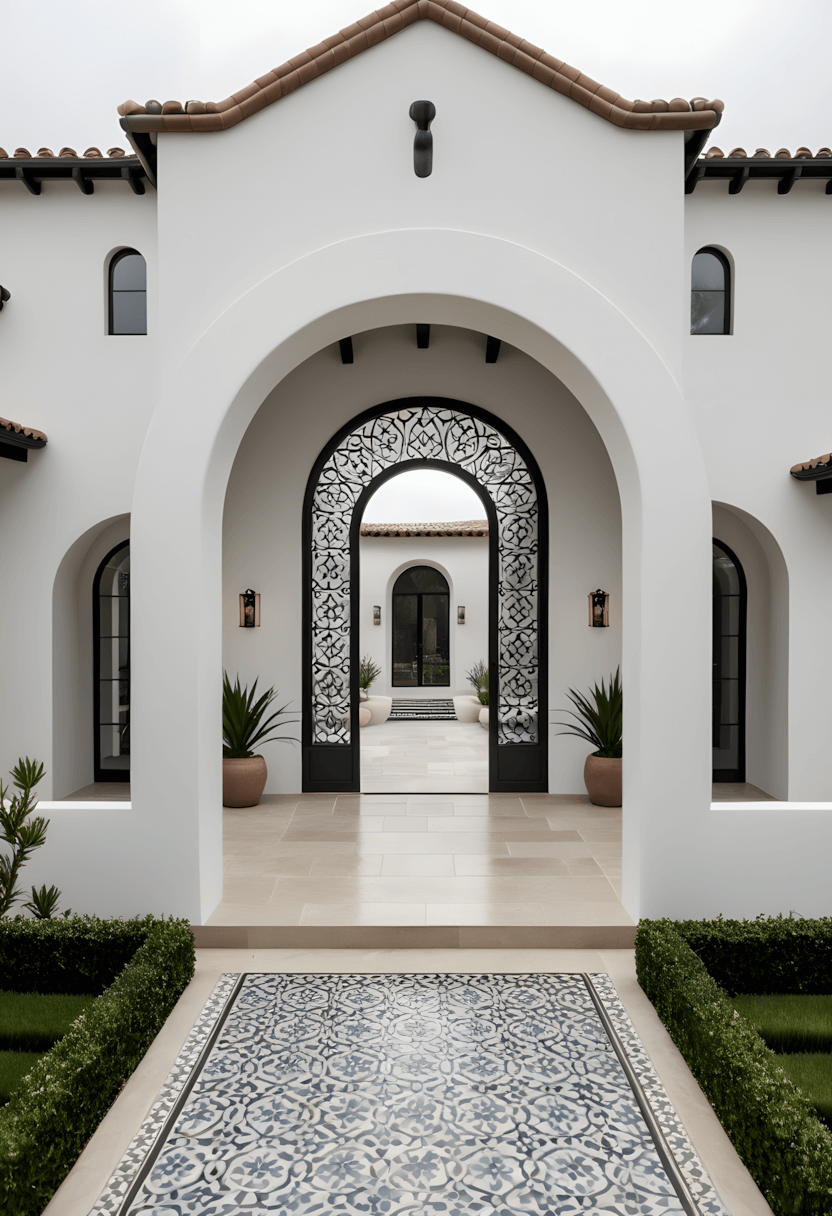
This streamlined approach often appeals to those wanting Spanish character with modern simplicity. Reduced ornamental complexity typically provides easier maintenance while maintaining essential Spanish proportions and materials.
Design consideration: Simplified designs often require careful attention to proportion while their cleaner lines can provide timeless appeal that works well with contemporary lifestyles.
Practical benefit: Streamlined features typically reduce maintenance costs while maintaining distinctive character that provides market differentiation without overwhelming complexity.
21. Rural Estate Integration
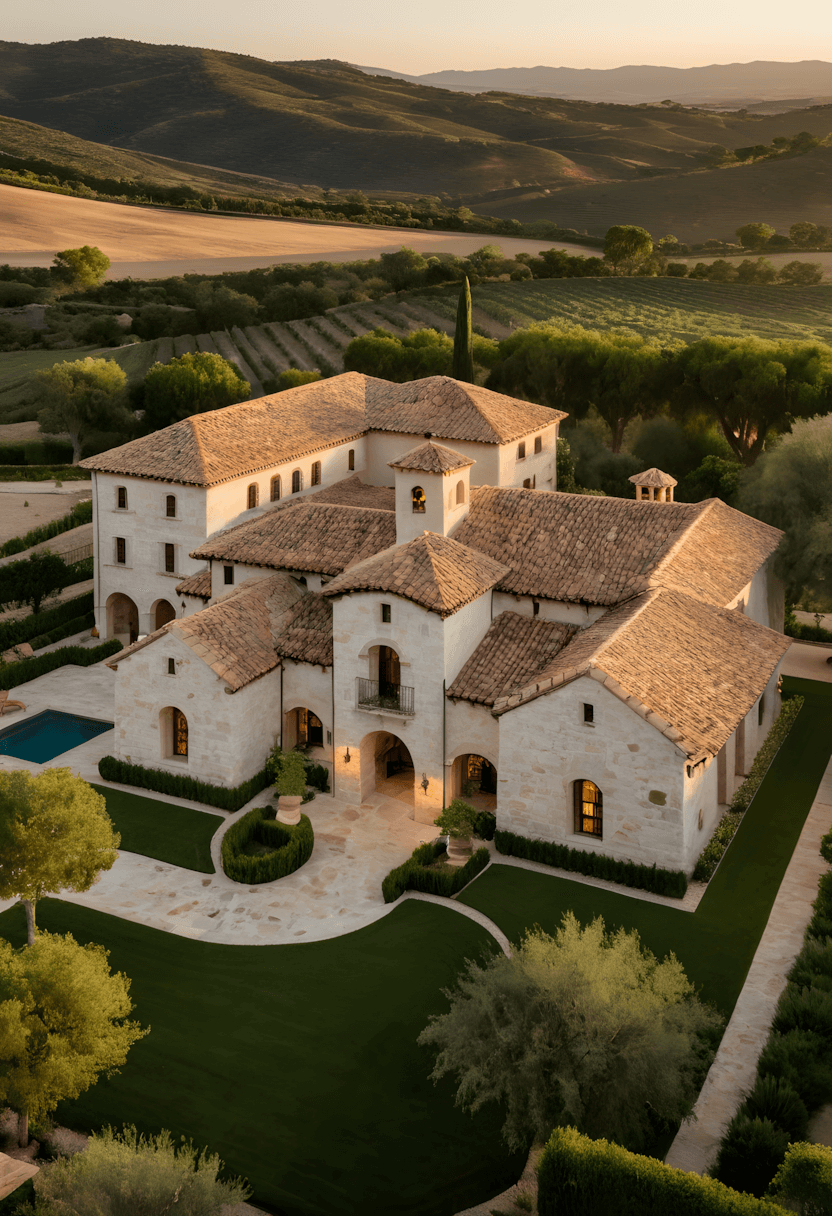
This expansive approach often appeals to homeowners with larger properties. Multiple building components typically provide varied functions while maintaining visual unity through consistent materials and design language.
Design consideration: Estate layouts often require comprehensive planning while their scale can accommodate diverse family needs and entertainment requirements.
Practical benefit: Comprehensive designs typically provide long-term flexibility while quality estate planning can create properties that serve multiple generations effectively.
Understanding Spanish-Style Architecture
Through various Mediterranean-inspired architectural projects, I’ve observed that successful Spanish-style homes often balance traditional aesthetic elements with practical modern performance requirements. These designs typically succeed because they honor historical architectural principles while adapting to contemporary family needs and climate considerations.
The Spanish-style approach often works well for modern homeowners because it typically creates homes that feel both distinctive and livable. Effective implementation usually involves understanding the relationship between indoor and outdoor spaces, selecting appropriate materials for local climate conditions, and maintaining proper proportions that honor traditional Spanish design principles.
Planning considerations often include assessing your lot’s orientation for optimal climate response, local building codes that may affect historical details, and budget allocation between authentic materials and modern performance features. Many successful projects prioritize key Spanish elements like tile roofing and stucco walls while finding cost-effective ways to incorporate traditional details that enhance character without overwhelming construction budgets.
Remember: For any structural modifications, roofing changes, electrical work, or major architectural alterations, always consult with licensed professionals to ensure proper engineering, code compliance, and integration with existing building systems.

